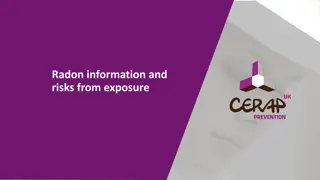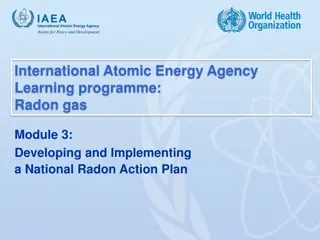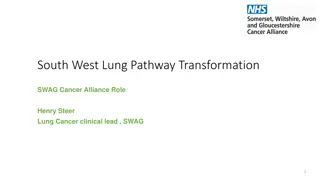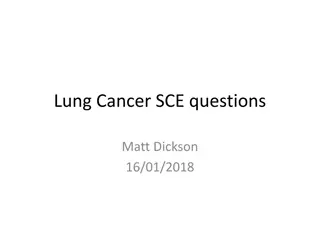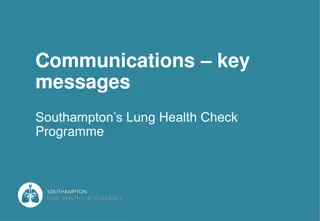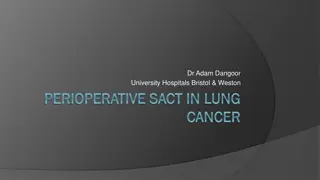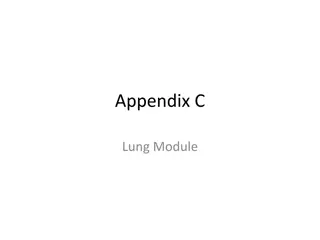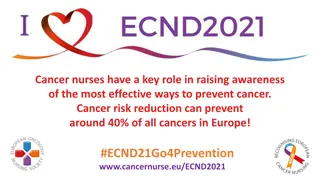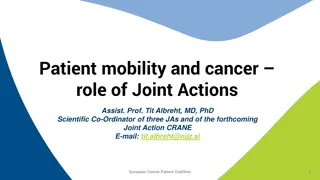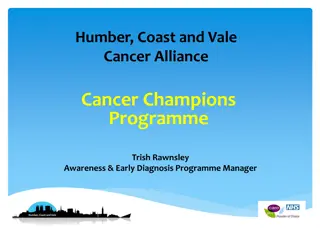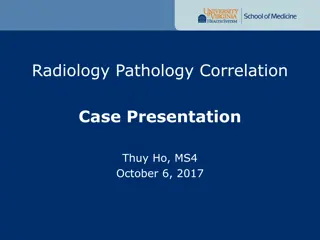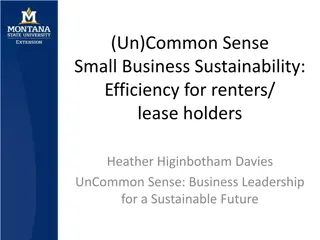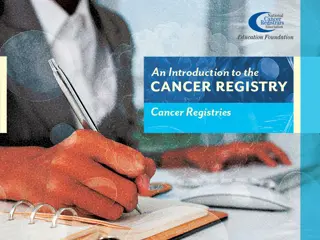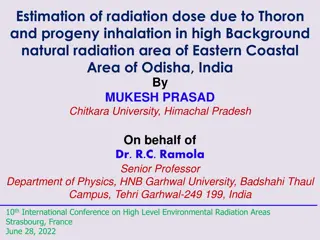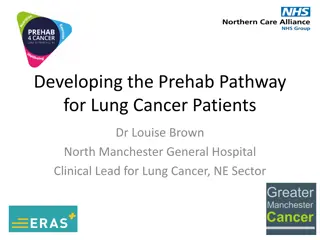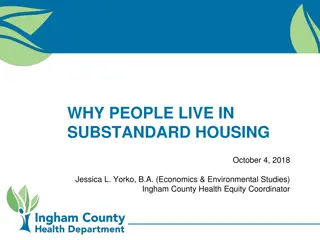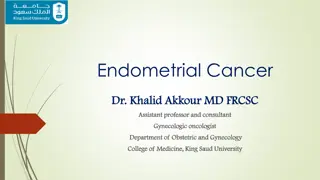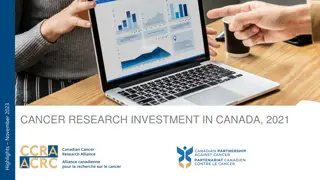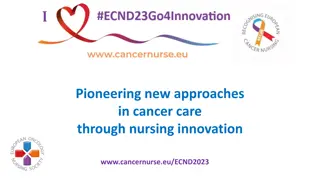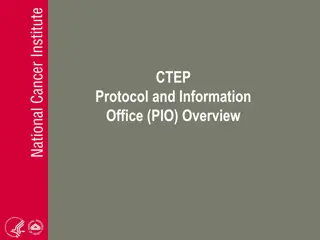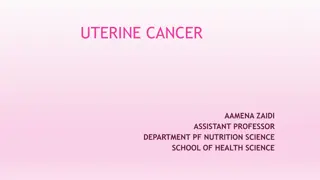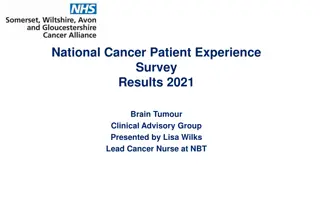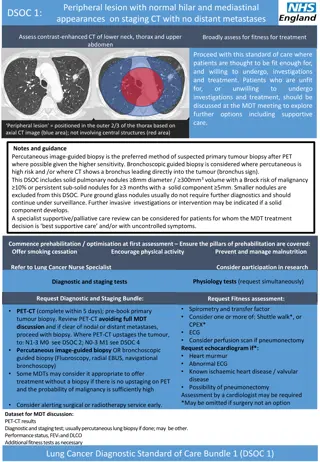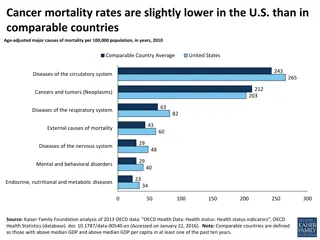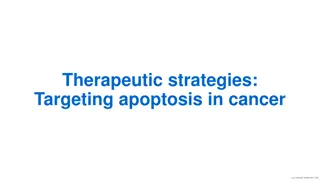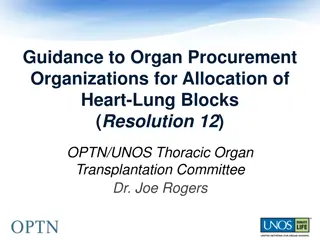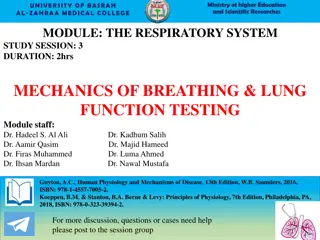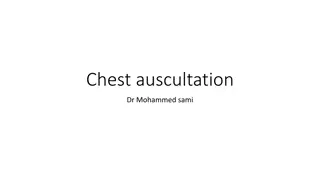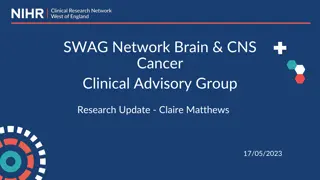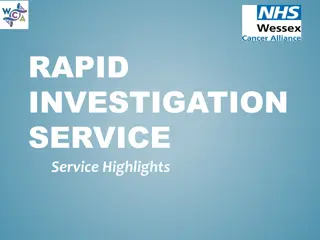Addressing Lung Cancer Risk in Renters: Strategies for Radon Reduction
Lung cancer risk in renters due to radon exposure is a significant concern, especially for those in lower-income brackets. This article sheds light on the synergistic risks of radon and tobacco smoke, emphasizing the importance of reducing radon levels in rental properties to safeguard the health of occupants. Strategies to empower renters, increase radon testing, and promote healthy indoor environments are discussed to mitigate lung cancer risks effectively.
Download Presentation

Please find below an Image/Link to download the presentation.
The content on the website is provided AS IS for your information and personal use only. It may not be sold, licensed, or shared on other websites without obtaining consent from the author. Download presentation by click this link. If you encounter any issues during the download, it is possible that the publisher has removed the file from their server.
E N D
Presentation Transcript
Reducing Lung Cancer Risk in Renters Through Radon Reduction Karen M. Butler, DNP, RN; Renee Fox, MS; Kathy Rademacher, BA; Amber Deller, RN, CRC; Dawn Molina, MSN, FNP-BC; & Ellen J. Hahn, PhD, RN, FAAN University of Kentucky College of Nursing The 2017 International Radon Symposium
BREATHE Who We Are Our Vision: Our Mission: To promote lung health and healthy environments to achieve health equity through a) research; b) community outreach and empowerment; c) advocacy and policy development; and d) access to health services. All people will have access to clean air and live in healthy environments. The 2017 International Radon Symposium
Impacts on Health Common Hazards Fires & falls Secondhand smoke Radon gas Carbon monoxide Pesticides Firearms Structure & Safety Air quality Water quality Chemicals Resident behavior Neighborhood Surgeon General Call to Action to Promote Healthy Homes, 2009 The 2017 International Radon Symposium
Tobacco, Radon, & Lung Cancer Tobacco Smoke 85% lung cancer cases caused by tobacco smoke. 3,000 lung cancer deaths per year among nonsmokers from secondhand smoke Radon 20,000 lung cancer deaths per year from radon exposure (only 2,100-2,900 among never smokers) Of those exposed to at least 4 pCi/L of radon, the risk of developing lung cancer is estimated at 62/1,000 for smokers and 7/1,000 for nonsmokers. Most never smokers with lung cancer are women. The 2017 International Radon Symposium
Synergistic Risk Breathing radon is dangerous, but it is more harmful when you also breathe tobacco smoke (or have exposure to tobacco smoke in your lifetime). People who are not exposed to tobacco smoke can still get radon-induced lung cancer. There are no safe levels of either radon or secondhand smoke. The 2017 International Radon Symposium
Renters are an At-Risk Population Environmental risks for lung cancer are inversely related to income. Environmental health protective behaviors occur more often in owner-occupied homes. Households with smokers are less likely to test for radon. Those below poverty & with less education: more likely to smoke. less likely to attempt to stop smoking than those with higher SES. disproportionately exposed to secondhand smoke. The 2017 International Radon Symposium
Landlords, Smoke-free Policies, and Radon Landlordsfear that smoke-free polices may hurt their business. Those living in a single family home or townhouse demonstrate increased awareness of radon and radon testing, compared to those living in apartments or condominiums. Landlords responsible for mitigating if radon levels are high. The 2017 International Radon Symposium
FRESH Renter Pilot Study R01ES021502 Study Purpose To explore the impact of a personalized environmental report- back intervention on home exposure. Study Sample Renters (N=47) received free radon and airborne nicotine test kits and were instructed on how to use them at enrollment. . The 2017 International Radon Symposium
FRESH Renter Pilot Study: Methods Knowledge and attitudes survey and home testing occurred at baseline and 15 months. Teachable moment phone conversation if at least one value was high. Personalized based on stage of readiness to take action and observed radon and airborne nicotine values. Taking action to reduce radon and SHS exposure was assessed at baseline and 3, 9 and 15 months post intervention. The 2017 International Radon Symposium
FRESH Pilot Renter Study: Intervention High radon: recommended landlord contact certified radon professional. If permission to contact landlord: offered voucher covering 30% of mitigation cost up to $600. High airborne nicotine levels: smoke-free home policy. Smoker in home: brief quitting intervention. Provided info to share with landlords to dispel perceived barriers to adopting smoke-free property policy. Both values low: received a mailed letter. The 2017 International Radon Symposium
FRESH Pilot Renter Study: Results Stage of action in home testing and in adopting a smoke-free home policy increased from baseline to 3 months; no further changes in stage of action were observed over time. Airborne nicotine declined from baseline to 15 months. Radon levels at 15 months were unchanged. Only two renters who tested high for radon talked with their landlords. None of the landlords redeemed the cost voucher. The 2017 International Radon Symposium
Lessons Learned: Landlord Involvement is Critical Renters expected landlords to be unsupportive, i.e. they would not fix radon due to cost. Renters expressed fear (having to move). Renters suggested if landlords were engaged before home testing they may perceive landlord as more supportive. Renters advised us to ask landlords to distribute study recruitment fliers in future studies. Is itethical to ask renters to test for radon (without landlord buy-in) when they do not have the ability to fix the problem? The 2017 International Radon Symposium
Lessons Learned: Recruiting & Retaining Renters a Challenge Feasibility of delivering FRESH with renters may require different strategies. By their nature, renters are transient and their daily lives may be insecure and chaotic. Attrition rates were very high, with only half of renters completing follow-up surveys. Although there were high exposure levels at baseline, existing programs do not reach this vulnerable and hard-to reach population. The 2017 International Radon Symposium
Lessons Learned: Summary Renters interested in home testing despite challenges with study retention. Renters liked testing and getting their data back. Renters skeptical that landlords would fix the problem; some expressed fear in sharing results with their landlord. Recruiting landlords, along with renters, in FRESH may prompt action to reduce radon and SHS exposure. The 2017 International Radon Symposium
Radon Reduction & Renters: Taking Action for a Healthy Home New study based on lessons learned in FRESH Pilot Study. Study Purpose: Examine the feasibility, acceptability, and challenges in recruiting landlords and renters to test their homes for radon in Appalachia. The 2017 International Radon Symposium
Study Objectives Recruit renters in an Appalachian West Virginia community to complete a brief survey and test their rental property for radon. Recruit landlords affiliated with at least 25% of the renter participants to assess their attitudes, experiences, policies, and practices related to smoking and radon risk reduction, as well as their general management practices (e.g. how they communicate with tenants). The 2017 International Radon Symposium
Study Design 40 renters recruited via email/flyer from their landlords or at clinics. Enrolled at home or clinic to complete brief confidential survey via iPad and offered free 3-day radon test kit; reminders to test. Radon results returned to the renter via letter mailed to their home, and shared with the landlord if the renter participant provides us permission to do so. Study personnel available to discuss results with renters and landlords and refer for mitigation as appropriate. At least 10 landlords invited to complete a brief telephone survey. No more than 4 renters per landlord. If Renter A, B, C, & D are affiliated with the same landlord and Renter E has that the same landlord, Renter E will not be eligible. The 2017 International Radon Symposium
Renter and Landlord Recruitment Paths into Study Renter sees flier and contacts study staff Study staff contacts Landlord (Landlord Phone Script B) Study staff explains overall study and asks renter: Can we contact your landlord? (Renter Eligibility Screen) Study staff explains overall study to landlord and asks: Will you share the study information with renters via approved flier and/or email? Yes No Yes No Contact landlord and explain the overall study. Ask landlord: Are you ok with renter testing for radon? (Landlord Phone Script A) Do not enroll renter Explain landlord study and ask landlord: Do you want to enroll in study? Yes No Yes No Explain landlord study and ask landlord: Do you want to enroll in study? Consent and enroll renter Do not enroll renter Do not enroll landlord Enroll landlord Yes No Do not enroll landlord Enroll landlord
Informed Consent Study personnel explain the study, answer questions, obtain signed consent, and enroll the renter participant. Waiver of documentation of informed consent for landlords. The 2017 International Radon Symposium
Participant Results Radon results will be returned to participants via letter mailed to their home, and shared with landlord if the renter participant gives permission to do so. Study personnel will be available to discuss results with renters and landlords and refer for mitigation. The 2017 International Radon Symposium
Enrollment Enrollment is anticipated to start in Fall 2017, and continue until the targeted sample of renters and landlords is recruited. The 2017 International Radon Symposium
Lung Cancer Age-Adjusted Mortality Rates by State, 2009 Data Source: CDC http://www.cdc.gov/cancer/lung/statistics/state.htm
Questions? Karen M. Butler, DNP, RN Professor & Assistant Dean of Academic Operations Co-Director, Radon Policy Division, BREATHE University of Kentucky College of Nursing Karen.Butler@uky.edu www.breathe.uky.edu For more information, contact us: www.radon.uky.edu www.kcsp.uky.edu 859-257-2358 The 2017 International Radon Symposium



